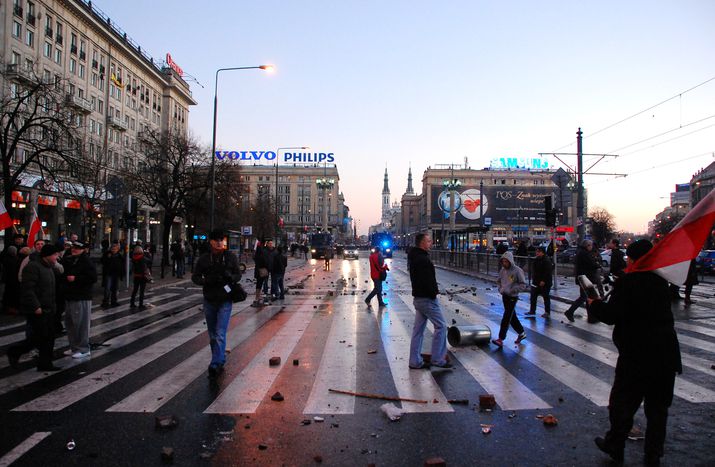
Panic on Warsaw streets: media view of Polish independence day celebrations
Published on
Translation by:
 Peter Robbins
Peter Robbins
A masked and angry crowd, rockets, bloodstained faces and burning cars. This was no war or terrorist attack but mere independence day celebrations - as seen by the Polish media
On 11 November, Poles celebrated 93 years of independence after over a century of partition by Russia, Germany and Austria. Fears had already been raised that the capital could see scuffles between nationalists and leftist extremists. That it did not quite come to this is credit to the success of the police operation. However, Warsaw’s celebrations did not pass completely without incident: separated from one another, groups of hooligans focused all their aggression on the police. According to the city’s police headquarters, 210 people were arrested and fines totalling 250, 000 złoty (£47, 827 or €55, 552) were issued. With police patrol vehicles wrecked and the cars of TV and radio stations also targeted, the destruction affected police equipment as well as the capital’s infrastructure. However, these hooligans represented only a small proportion of the people marching on the streets of Warsaw, a fact which the media chose to ignore as they concentrated more or less exclusively on the troublemakers.
Hooligans, burnt-out cars and walking wounded
When hooligans from both sides attacked the police, they were met with water cannons and tear gas. Admittedly there were riots, but surely everyone would agree that this kind of thing happens at most mass gatherings and is in no way representative of the event as a whole or the people taking part in it. The events of 11 November should not be seen as a protest. Warsaw’s troublemakers had no concrete demands or meaningful slogans. The only chants heard were anti-communist ones from one side and anti-fascist ones from the other. They were certainly not being led by any higher ideal. The situation that developed has nothing in common with the protests which have broken out across the world this year such as the 'indignant' movement which started in Madrid, occupy wall street in New York and the arab spring. The events in the Polish capital are nothing more or less than your everyday hooliganism.
This has nothing to do with the indignant movement, occupy wall street or the arab spring
‘Marches, barricades and riots on the streets – this is Polish Independence Day’, ‘Hooligans wreck Warsaw’, ‘Burnt-out cars, injuries. Warsaw counts its losses’ - these are just some of the many press headlines – but do they tell the whole story of what went on in Warsaw on 11 November? No, not really. Many people, even with small children, marched in an orderly fashion through the streets of Warsaw waving the country's white-and-red flags. However, the photographs taken of the event show only bloodstained faces, police firing water cannons, masked hooligans and burning cars. Seeing these images makes you wonder whether you should ever leave the house. It seems as if you need the courage of those who took part in the Warsaw uprising of 1944 just to participate in some celebrations.
‘Disarming German thugs in Warsaw’
The whole situation is given added spice by the fact that those arrested included 92 members of the German antifa (anti-fascist) movement, who came to Warsaw with the aim of disrupting the celebrations. Given the historical background, this is a very telling situation and one which is well illustrated by a statement from Artur Zawisza, vice-chairman of the independence march association: ‘On 11 November 1918 we had to disarm German troops in Warsaw and then on 11 November 2011 we had to disarm German thugs in Warsaw.’ However, we shouldn’t succumb to paranoia. No country is without its hooligans. Their appearance on the streets of Warsaw does not mean that Poland and the Poles are suddenly under attack. Nonetheless, the fact that such individuals have deliberately chosen to descend on the country could indeed be termed a ‘national shame’, in the words of Polish president Bronisław Komorowski.
‘In 1918, we disarmed German troops in Warsaw and in 2011, we disarmed German thugs in Warsaw’
Watching or reading the media report of the celebrations on 11 November, you could be forgiven for thinking that everyone taking part belonged to one of two groups – the fascists or the ‘traitors’ to the Polish nation. Where, then, is there space for the everyday Polish patriots, people who want to use this day to distance themselves from all political parties and groupings, right-wing or left-wing, and concentrate on celebrating their country’s independence without any subtext? Where can such a person go to commemorate the events of 1918 and their solidarity with their fellow countrymen without being pigeon-holed into one of the two groups?
This is part of a significantly deeper problem affecting the international as well as the national media. The vast majority of newspapers now commonly seeks out sensationalism and rely on negative emotions. It is clear that an image of a masked hooligan torching a car or kicking a passer-by will arouse more emotion than a report on the president’s speech beside the tomb of the unknown soldier. However, the media representatives need to realise that they are doing great harm in their scramble for viewing figures. In this case, it was wrong to damage Poland’s image both within the country and abroad. We can merely take solace from the fact that not everybody blindly believes what they see on television or read in the newspapers.
Image: © Andrzej Górz
Translated from Warszawa w ogniu? Obchody Narodowego Święta Niepodległości oczami mediów


